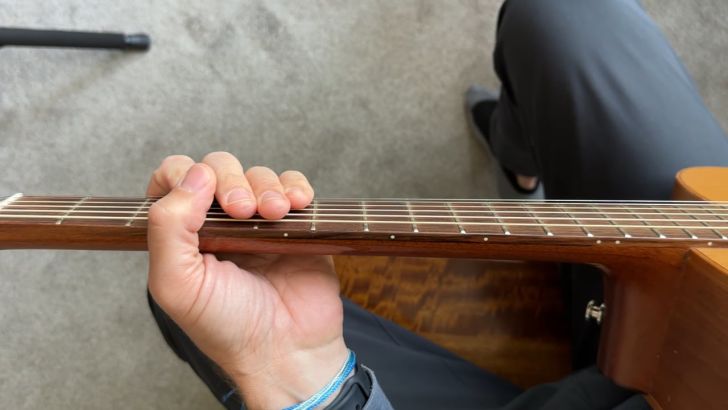RIFFS:
Dad, how do you NOT know the words to Call Me Al?!?
The question came from my seven year old, and it’s a good one.
You Can Call Me Al is the best-known song from my favorite album of all time. It’s been in constant rotation in my solo show for years, and it makes a fairly regular appearance in the kids’ playlists.
And yet.
There I was in our kitchen, struggling to recall the words. The reason is simple. I nuked my old, crappy rendition of the tune and started over with a completely new arrangement.
But it was too hard for me to play!
At a solo show, you’re the guitarist, the “bassist,” the “drummer,” AND the singer. It’s a lot of hats to wear. Tasked with managing all those bits at once, my brain simply ran out of bandwidth. I couldn’t even get the lyrics in my mouth (let alone sing them in tune & with a bit of swagger).
You’re good at stuff.
The people who read this newsletter tend to be badasses. Y’all are software engineers, doctors, students, executives, business owners, and a dozen other things that require actual skills.
And that’s the problem.
We’ve forgotten how to suck at stuff! In school, you aren’t rewarded for exploring some new area where you’re unskilled. You’re rewarded for having the right answer. When was the last time you took something that works fine, intentionally broke it, just so you could (maybe) build it back better than before?
That’s what practice is.
Imagine a kanban board with three columns:
In our minds, getting better is a steady march of skills from left to right. But that’s not how it actually works. Experts regularly take automated skills from the C column and drag them back into the B column:

Your mission this week:
Go find something you can do on autopilot. De-automate it. Tweak it. Suck at it again (so you can fix it up better than before).
Let me know how it goes down in the comments!
RECS:
Need further permission or encouragement?
Then I recommend this great 6-minute video from Chris Hayzel:
CHARTS:
Let’s learn You Can Call Me Al.
In this Dropbox folder, you’ll find:
PDFs for guitar, bass, & drums
the Sibelius file
& a .musicXML file you can open in other programs
Here’s the SoundSlice for this guitar part:
Oh and why not—here’s my solo arrangement:
intro / chorus (SoundSlice)
verse - first half (SoundSlice)
verse - second half (SoundSlice)
penny whistle solo/slap bass break (SoundSlice)
(Click those SoundSlice links for TAB)
SMARTS:
Let’s do something different here.
Usually in this section I walk you through some tidbits from the chart: the key, a strange chord name, a rhythm you should know, a charting convention that needs explaining.
But today I want to unpack the thought process behind the solo arrangement.
#1 - This song is repetitive.
The original is built on two things:
Layers & textures. The layering & unlayering of parts creates textures.
Dynamics. If you play the verses quieter, it makes room for the vocal. (Dynamics also make the loud choruses sound even louder.)
My old arrangement had neither of these things—it was just a shouty mess with non-faithful chord changes. To make the new improved version, I knew I needed to…
#2 - Be the whole band.
SO many iconic parts:
Ray Phiri’s circle-logic guitar part
Bakithi Kumalo’s groovy bass line (and solo!)
Morris Goldberg’s penny whistle solo
the horn hits
drums & percussion galore
oh… and most of this while singing
One great thing about playing covers is that nostalgia fills a lot of gaps. We can hint at a part, and people’s imaginations will do the heavy lifting for us.
(Something I’ve been doing so long that I’d have to try not to do: percussive strums on 2 & 4 to mimic the backbeat of the snare.)
#3 - Groove rules all things.
When I was younger, I failed at this.
I kept adding more, but I neglected the foundation.
If it’s not groovy, it’s worthless.
Seriously—90% of being good at music comes down to:
play in time
sing in tune
use dynamics
To help you with time, I put this drum loop in the Dropbox folder.
Just drag it into any DAW. It’s at 128 bpm, but you can adjust the tempo from there.
(Oh: and if your rhythm needs a tune-up, check out RhythmOS.)
#4 - Surprise & delight.
Live music is a service business.
The best opportunities are where the expectations are lowest. Luckily for us, decades of mediocre solo acoustic musicians allow us to surprise & delight on nearly every front.
That definitely includes our arrangements:
That’s all I got this week.
See you next Wednesday,
Josh
ps. Leave a comment telling me about a skill you de-automated this week.







Sorry, nothing about de-automating from me but rather an appreciation for this post. As someone who spent 30 years in the tech industry and only started in music the last few years with retirement I never thought about mixing those worlds. Showing music learning via kanban boards, well... a light is turning on in my head. Thanks.